The cholesterol esterase market is projected to reach USD 258.7 million by 2025 and is expected to expand significantly to USD 601.2 million by 2035, reflecting a robust compound annual growth rate (CAGR) of 8.8%. This growth underscores the rising demand for cholesterol esterase in clinical diagnostics, pharmaceutical applications, and biotechnological research.
Increasing prevalence of cardiovascular diseases and growing awareness about lipid management are driving laboratories and healthcare providers to adopt precise enzymatic testing solutions. The market expansion also highlights the role of advanced biocatalysts in improving assay accuracy and efficiency. The market trajectory indicates a future where cholesterol esterase solutions become indispensable in routine health screenings, research applications, and therapeutic monitoring across global healthcare systems.
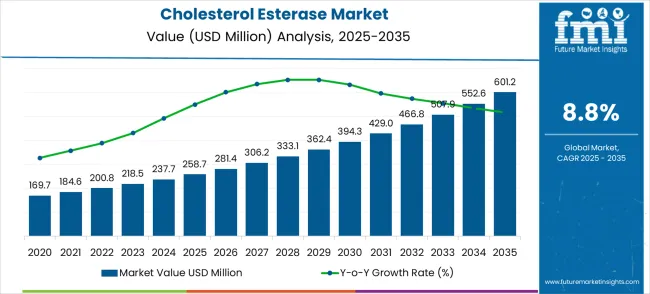
| Metric | Value |
|---|---|
| Estimated Value in (2025E) | USD 258.7 million |
| Forecast Value in (2035F) | USD 601.2 million |
| Forecast CAGR (2025 to 2035) | 8.8% |
A major factor contributing to market growth is the increased focus on diagnostic efficiency and laboratory automation. The year-on-year (YoY) growth trend demonstrates steady upward momentum, with market values rising from USD 169.7 million in 2023 to USD 258.7 million in 2025, continuing to climb sharply over the next decade. The adoption of cholesterol esterase in automated analyzer systems enhances testing throughput, reduces manual errors, and ensures reliable results. Furthermore, strategic partnerships between enzyme manufacturers and clinical laboratories are fostering greater accessibility. Government initiatives promoting cardiovascular health awareness, along with rising research in lipid metabolism and therapeutic development, further reinforce the market’s long-term potential and continuous revenue generation opportunities.
Looking ahead, the cholesterol esterase market is projected to sustain strong growth, with market values reaching USD 429 million by 2030 and eventually USD 601.2 million by 2035, reflecting consistent expansion supported by a CAGR of 8.8%. The steady year-on-year increase underscores the growing importance of cholesterol esterase in preventive healthcare, clinical diagnostics, and pharmaceutical research. As lipid profiling and personalized medicine continue to gain traction globally, demand for precise enzymatic assays is expected to rise substantially. Innovations in enzyme formulation, improved stability, and integration into high-throughput diagnostic platforms will further accelerate market adoption.
Market expansion is being supported by the increasing global prevalence of cardiovascular diseases and the corresponding need for accurate diagnostic enzymes that can provide reliable cholesterol measurement while maintaining consistent performance across various clinical diagnostic and pharmaceutical research applications. Modern healthcare facilities are increasingly focused on implementing diagnostic solutions that can deliver superior accuracy, reduce testing time, and provide reliable results in automated laboratory systems and point-of-care testing devices. Cholesterol esterase enzymes' proven ability to provide exceptional specificity, optimal reaction kinetics, and stable performance makes them essential components for contemporary cardiovascular diagnostics and lipid metabolism research applications.
The growing emphasis on preventive healthcare and personalized medicine is driving demand for cholesterol esterase that can support advanced diagnostic testing, enable comprehensive lipid profiling, and improve patient care through enhanced diagnostic capabilities. Healthcare providers' preference for reagents that combine analytical accuracy with operational reliability and cost-effectiveness is creating opportunities for innovative enzyme implementations. The rising influence of aging populations and lifestyle-related health concerns is also contributing to increased adoption of cholesterol testing solutions that can provide reliable diagnostic insights without compromising testing quality or laboratory efficiency.
The market is segmented by source type, application, and region. By source type, the market is divided into animal-derived cholesterol esterase, microbial-derived cholesterol esterase, recombinant cholesterol esterase, and others. Based on application, the market is categorized into food processing, reagent diagnostics, and pharmaceuticals. Regionally, the market is divided into North America, Europe, East Asia, South Asia & Pacific, Latin America, and the Middle East & Africa.
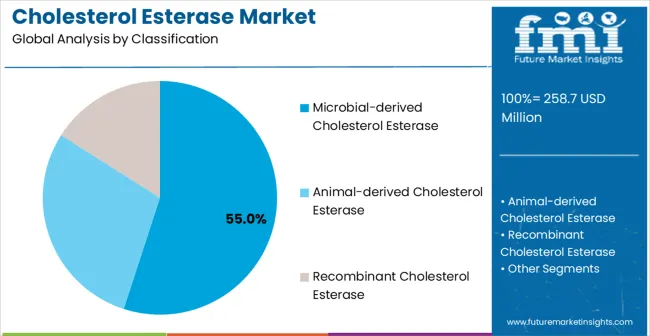
The microbial-derived cholesterol esterase segment is projected to account for 55% of the cholesterol esterase market in 2025, reaffirming its position as the leading source type category. Diagnostic and pharmaceutical companies increasingly utilize microbial-derived enzymes for their superior production scalability, consistent quality characteristics, and cost-effective manufacturing advantages compared to animal-derived alternatives in diagnostic assay and pharmaceutical research applications. Microbial production technology's established fermentation processes and quality control capabilities directly address the industrial requirements for reliable enzyme supply and operational efficiency in large-scale diagnostic manufacturing.
This source type segment forms the foundation of modern enzyme production operations, as it represents the production method with the greatest scalability and established market acceptance across multiple healthcare sectors and research applications. Manufacturer investments in enhanced fermentation technologies and enzyme purification processes continue to strengthen adoption among diagnostic companies. With healthcare organizations prioritizing supply chain reliability and cost-effectiveness, microbial-derived cholesterol esterase aligns with both operational efficiency objectives and quality assurance requirements, making it the central component of comprehensive enzyme supply strategies.
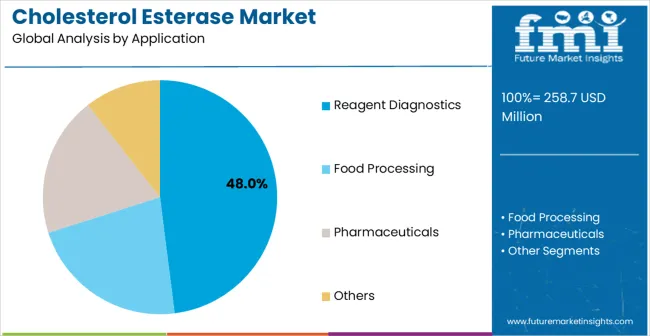
Reagent diagnostics applications are projected to represent 48% of cholesterol esterase demand in 2025, underscoring their critical role as the primary consumers of enzymatic reagents for clinical cholesterol testing, lipid profiling, and cardiovascular risk assessment applications. Diagnostic manufacturers prefer cholesterol esterase for its exceptional specificity, optimal enzymatic activity, and ability to enhance assay performance while reducing testing complexity and improving result reliability. Positioned as essential components for modern clinical diagnostics, cholesterol esterase enzymes offer both analytical advantages and operational benefits.
The segment is supported by continuous innovation in diagnostic technologies and the growing availability of automated testing systems that enable comprehensive lipid analysis with enhanced throughput and accuracy capabilities. Additionally, diagnostic manufacturers are investing in advanced enzyme formulations to support high-volume testing operations and consistent quality assurance. As cardiovascular disease screening becomes more prevalent and diagnostic automation increases, reagent diagnostics will continue to dominate the application market while supporting advanced enzyme utilization and testing optimization strategies.
The cholesterol esterase market is advancing rapidly due to increasing cardiovascular disease prevalence and growing demand for accurate diagnostic enzymes that provide reliable cholesterol measurement and enhanced assay performance across diverse clinical diagnostic and pharmaceutical research applications. However, the market faces challenges, including enzyme stability requirements, stringent regulatory approvals, and the need for specialized storage and handling protocols. Innovation in enzyme engineering technologies and recombinant production systems continues to influence product development and market expansion patterns.
The growing adoption of advanced enzyme engineering and recombinant DNA technologies is enabling manufacturers to produce sophisticated cholesterol esterase variants with enhanced stability, improved specificity, and optimized performance characteristics. Recombinant production systems provide better quality control while allowing more consistent enzyme properties and scalable manufacturing across various diagnostic and research applications. Manufacturers are increasingly recognizing the competitive advantages of engineered enzyme capabilities for product differentiation and premium market positioning.
Modern cholesterol esterase producers are incorporating automated fermentation and purification systems to enhance production efficiency, ensure consistent enzyme quality, and provide comprehensive quality control throughout the manufacturing process. These technologies improve product reliability while enabling new capabilities, including custom enzyme formulations and specialized application development. Advanced automation integration also allows manufacturers to support scalable production models and enhanced functionality beyond traditional enzyme manufacturing processes.
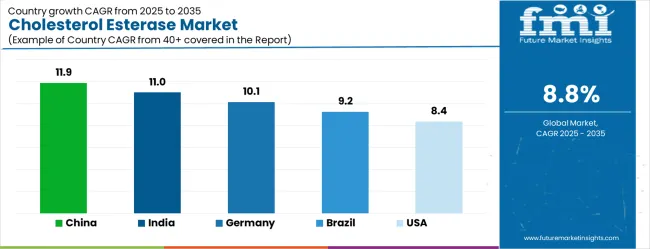
| Country | CAGR (2025-2035) |
|---|---|
| China | 11.9% |
| India | 11.0% |
| Germany | 10.1% |
| Brazil | 9.2% |
| USA | 8.4% |
| UK | 7.5% |
| Japan | 6.6% |
The cholesterol esterase market is experiencing strong growth globally, with China leading at an 11.9% CAGR through 2035, driven by the expanding healthcare infrastructure, growing pharmaceutical manufacturing sector, and increasing government investment in diagnostic technology development and cardiovascular disease prevention programs. India follows at 11.0%, supported by rapid healthcare modernization, rising prevalence of lifestyle diseases, and growing adoption of advanced diagnostic technologies in clinical laboratories. Germany shows growth at 10.1%, emphasizing biotechnology innovation and premium enzyme development. Brazil records 9.2%, focusing on healthcare system expansion and diagnostic technology adoption. The USA demonstrates 8.4% growth, prioritizing advanced diagnostic technologies and pharmaceutical research applications. The UK exhibits 7.5% growth, with a focus on biotechnology development and diagnostic innovation. Japan shows 6.6% growth, supported by advanced enzyme manufacturing and precision diagnostic technologies.
The report covers an in-depth analysis of 40+ countries top-performing countries are highlighted below.
Revenue from cholesterol esterase in China is projected to exhibit exceptional growth with a CAGR of 11.9% through 2035, driven by rapidly expanding healthcare infrastructure and significant government investment in biotechnology development supported by national health improvement initiatives and pharmaceutical manufacturing modernization programs. The country's massive healthcare system development and increasing emphasis on cardiovascular disease prevention are creating substantial demand for diagnostic enzyme solutions. Major biotechnology companies and pharmaceutical manufacturers are establishing comprehensive enzyme production capabilities to serve both domestic and international markets.
Revenue from cholesterol esterase in India is expanding at a CAGR of 11.0%, supported by the country's comprehensive healthcare modernization programs, rising prevalence of cardiovascular diseases, and increasing adoption of advanced diagnostic technologies in urban and rural healthcare facilities. The country's expanding pharmaceutical industry and growing focus on preventive healthcare are driving demand for diagnostic enzyme capabilities. International biotechnology providers and domestic companies are establishing extensive production and distribution capabilities to address the growing demand for enzymatic diagnostic solutions.
Revenue from cholesterol esterase in Germany is expanding at a CAGR of 10.1%, supported by the country's advanced biotechnology sector, strong emphasis on enzyme engineering innovation, and robust demand for high-quality diagnostic reagents among leading pharmaceutical and diagnostic companies. The nation's mature biotechnology industry and commitment to precision medicine are driving the development of sophisticated enzymes throughout research institutions and manufacturing facilities. Leading biotechnology companies and enzyme manufacturers are investing extensively in premium product development and advanced production technologies to serve both domestic and European markets.
Revenue from cholesterol esterase in Brazil is growing at a CAGR of 9.2%, driven by expanding healthcare infrastructure, increasing investment in biotechnology development, and raising awareness about the importance of cardiovascular disease prevention and diagnostic testing. The country's healthcare system modernization and emphasis on preventive medicine are supporting demand for diagnostic enzyme technologies across major healthcare facilities. Biotechnology companies and pharmaceutical manufacturers are establishing comprehensive capabilities to serve growing domestic demand and regional market opportunities.
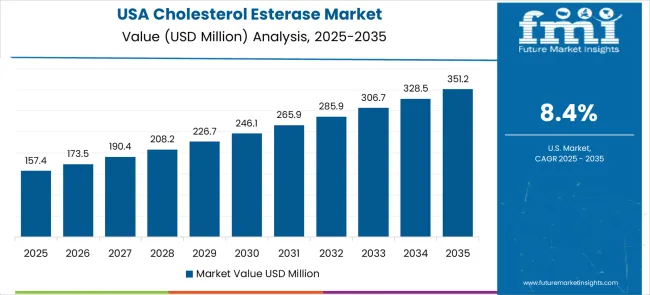
Revenue from cholesterol esterase in the USA is expanding at a CAGR of 8.4%, supported by the country's advanced biotechnology industry, strong emphasis on pharmaceutical research, and established demand for innovative diagnostic technologies among leading healthcare institutions and pharmaceutical companies. The USA's mature enzyme manufacturing sector and leadership in biotechnology innovation are driving demand for sophisticated enzyme products focusing on research applications and premium diagnostic solutions. Biotechnology companies are investing in comprehensive research and development to serve pharmaceutical, diagnostic, and academic markets with cutting-edge enzyme technologies.
Revenue from cholesterol esterase in the UK is growing at a CAGR of 7.5%, driven by the country's established biotechnology sector, emphasis on diagnostic innovation, and strong demand for quality enzyme products in pharmaceutical research and clinical diagnostic applications. The UK's biotechnology industry heritage and commitment to healthcare innovation are supporting investment in advanced enzyme development capabilities. Industry leaders are establishing comprehensive research programs to serve both domestic and European markets with premium enzyme products.
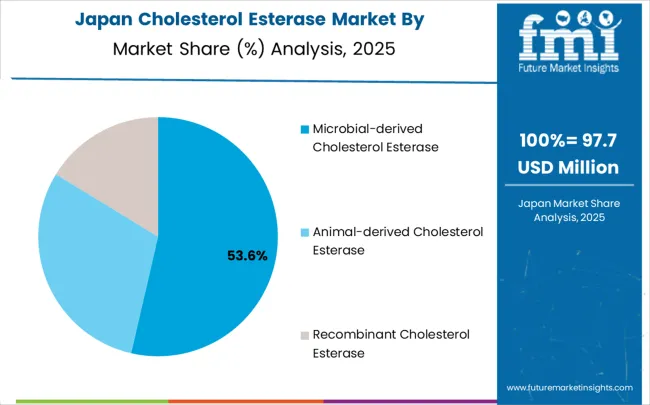
Revenue from cholesterol esterase in Japan is expanding at a CAGR of 6.6%, supported by the country's focus on advanced enzyme manufacturing, precision biotechnology development, and strong emphasis on quality control and product excellence in pharmaceutical and diagnostic applications. Japan's sophisticated biotechnology industry and commitment to technological innovation are driving demand for advanced enzyme technologies, including high-purity products and specialized formulations. Leading biotechnology companies are investing in specialized capabilities to serve pharmaceutical research, diagnostic manufacturing, and academic research segments with premium enzyme offerings.
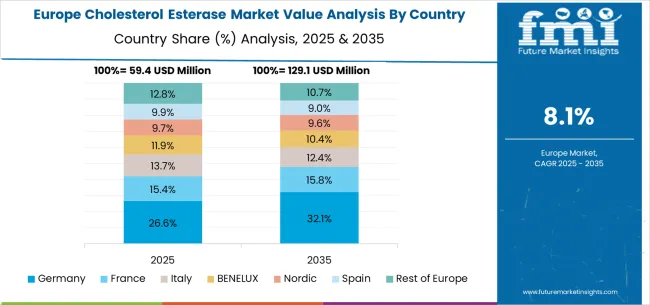
The cholesterol esterase market in Europe is projected to grow from USD 56.9 million in 2025 to USD 132.3 million by 2035, registering a CAGR of 8.8% over the forecast period. Germany is expected to maintain its leadership position with a 32.0% market share in 2025, declining slightly to 31.5% by 2035, supported by its strong biotechnology sector, advanced pharmaceutical industry, and comprehensive enzyme manufacturing supply network serving major European markets.
France follows with an 18.0% share in 2025, projected to reach 18.5% by 2035, driven by robust demand for diagnostic reagents, pharmaceutical research applications, and biotechnology development programs, combined with established research traditions incorporating advanced enzyme technologies. The United Kingdom holds a 15.5% share in 2025, expected to decrease to 15.0% by 2035, supported by strong biotechnology research but facing challenges from economic conditions and competitive pressures from continental suppliers. Italy commands a 12.0% share in 2025, projected to reach 12.2% by 2035, while Spain accounts for 9.0% in 2025, expected to reach 9.3% by 2035. The Netherlands maintains a 4.5% share in 2025, growing to 4.7% by 2035. The Rest of Europe region, including Nordic countries, Eastern Europe, Portugal, Belgium, Switzerland, and Austria, is anticipated to maintain steady growth, with its collective share remaining at 9.0% to 9.3% by 2035, attributed to increasing adoption of biotechnology solutions in Nordic countries and growing pharmaceutical activities across Eastern European markets implementing healthcare modernization programs.
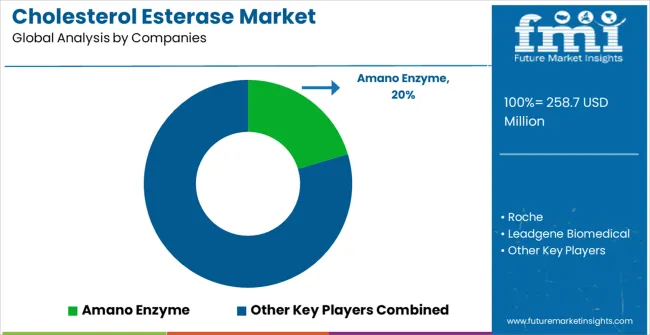
The cholesterol esterase market is characterized by competition among established enzyme manufacturers, specialized biotechnology companies, and integrated pharmaceutical ingredient suppliers. Companies are investing in enzyme engineering research, production process optimization, quality control systems, and comprehensive product portfolios to deliver pure, stable, and high-performance enzyme solutions. Innovation in recombinant production technologies, enzyme stabilization methods, and specialized formulations is central to strengthening market position and competitive advantage.
Amano Enzyme leads the market with a strong market share, offering comprehensive enzyme solutions with a focus on industrial and diagnostic applications. Roche provides specialized diagnostic reagents and enzyme technologies with an emphasis on clinical laboratory applications and automated testing systems. Leadgene Biomedical delivers innovative biotechnology products with a focus on enzyme development and pharmaceutical applications.
FUJIFILM Wako specializes in high-purity reagents and enzyme products for research and diagnostic markets. Creative Enzymes focuses on custom enzyme development and specialized biotechnology solutions. CDH Fine Chemical offers comprehensive enzyme manufacturing with emphasis on quality and reliability.
The cholesterol esterase market, valued at USD 258.7 million in 2025 and projected to reach USD 601.2 million by 2035 at an 8.8% CAGR, represents a specialized biotechnology segment driven by cardiovascular disease prevalence and diagnostic testing demands. Dominated by microbial-derived enzymes (55.0% market share) and reagent diagnostics applications (48.0% market share), the market faces challenges including enzyme stability requirements, stringent regulatory approvals, and specialized handling protocols. Success requires coordinated efforts across biotechnology companies, diagnostic manufacturers, healthcare providers, regulatory agencies, and research institutions.
How Governments Could Accelerate Biotechnology Innovation and Healthcare Access?
How Industry Associations Could Strengthen Technical Standards and Market Development?
How Biotechnology Companies and Enzyme Manufacturers Could Drive Innovation?
How Diagnostic Manufacturers and Healthcare Providers Could Optimize Implementation?
How Investors and Financial Enablers Could Support Market Expansion?
| Items | Values |
|---|---|
| Quantitative Units (2025) | USD 258.7 million |
| Source Type | Animal-derived Cholesterol Esterase, Microbial-derived Cholesterol Esterase, Recombinant Cholesterol Esterase, Others |
| Application | Food Processing, Reagent Diagnostics, Pharmaceuticals |
| Regions Covered | North America, Europe, East Asia, South Asia & Pacific, Latin America, Middle East & Africa |
| Countries Covered | United States, Canada, United Kingdom, Germany, France, China, Japan, South Korea, India, Brazil, Australia and 40+ countries |
| Key Companies Profiled | Amano Enzyme, Roche, Leadgene Biomedical, FUJIFILM Wako, Creative Enzymes, and CDH Fine Chemical |
| Additional Attributes | Dollar sales by source type and application category, regional demand trends, competitive landscape, technological advancements in enzyme engineering, recombinant production innovation, quality control optimization, and supply chain optimization |
The global cholesterol esterase market is estimated to be valued at USD 258.7 million in 2025.
The market size for the cholesterol esterase market is projected to reach USD 601.2 million by 2035.
The cholesterol esterase market is expected to grow at a 8.8% CAGR between 2025 and 2035.
The key product types in the cholesterol esterase market are animal-derived cholesterol esterase, microbial-derived cholesterol esterase, recombinant cholesterol esterase, and others.
In terms of application, the reagent diagnostics segment is expected to command 48.0% share in the cholesterol esterase market in 2025.






Our Research Products

The "Full Research Suite" delivers actionable market intel, deep dives on markets or technologies, so clients act faster, cut risk, and unlock growth.

The Leaderboard benchmarks and ranks top vendors, classifying them as Established Leaders, Leading Challengers, or Disruptors & Challengers.

Locates where complements amplify value and substitutes erode it, forecasting net impact by horizon

We deliver granular, decision-grade intel: market sizing, 5-year forecasts, pricing, adoption, usage, revenue, and operational KPIs—plus competitor tracking, regulation, and value chains—across 60 countries broadly.

Spot the shifts before they hit your P&L. We track inflection points, adoption curves, pricing moves, and ecosystem plays to show where demand is heading, why it is changing, and what to do next across high-growth markets and disruptive tech

Real-time reads of user behavior. We track shifting priorities, perceptions of today’s and next-gen services, and provider experience, then pace how fast tech moves from trial to adoption, blending buyer, consumer, and channel inputs with social signals (#WhySwitch, #UX).

Partner with our analyst team to build a custom report designed around your business priorities. From analysing market trends to assessing competitors or crafting bespoke datasets, we tailor insights to your needs.
Supplier Intelligence
Discovery & Profiling
Capacity & Footprint
Performance & Risk
Compliance & Governance
Commercial Readiness
Who Supplies Whom
Scorecards & Shortlists
Playbooks & Docs
Category Intelligence
Definition & Scope
Demand & Use Cases
Cost Drivers
Market Structure
Supply Chain Map
Trade & Policy
Operating Norms
Deliverables
Buyer Intelligence
Account Basics
Spend & Scope
Procurement Model
Vendor Requirements
Terms & Policies
Entry Strategy
Pain Points & Triggers
Outputs
Pricing Analysis
Benchmarks
Trends
Should-Cost
Indexation
Landed Cost
Commercial Terms
Deliverables
Brand Analysis
Positioning & Value Prop
Share & Presence
Customer Evidence
Go-to-Market
Digital & Reputation
Compliance & Trust
KPIs & Gaps
Outputs
Full Research Suite comprises of:
Market outlook & trends analysis
Interviews & case studies
Strategic recommendations
Vendor profiles & capabilities analysis
5-year forecasts
8 regions and 60+ country-level data splits
Market segment data splits
12 months of continuous data updates
DELIVERED AS:
PDF EXCEL ONLINE
Cholesterol Medicine Market Size and Share Forecast Outlook 2025 to 2035
Cholesterol and Lipid Test Market Size and Share Forecast Outlook 2025 to 2035
Cholesterol Monitors Market Size and Share Forecast Outlook 2025 to 2035
Cholesterol API Market Analysis - Size, Share, and Forecast 2025 to 2035
Cholesterol Control Supplements Market – Growth, Demand & Health Trends
Cholesterol Reduced Butter Market
HDL Cholesterol Kits Market Size and Share Forecast Outlook 2025 to 2035
Point-of-care Cholesterol Monitoring Device Market Size and Share Forecast Outlook 2025 to 2035
Low-Fat and Low-Cholesterol Diet Market Growth - Health Trends 2025 to 2035
Heterozygous Familial Hypercholesterolemia (HEFH) Management Market Trends - Innovations & Growth 2025 to 2035

Thank you!
You will receive an email from our Business Development Manager. Please be sure to check your SPAM/JUNK folder too.
Chat With
MaRIA